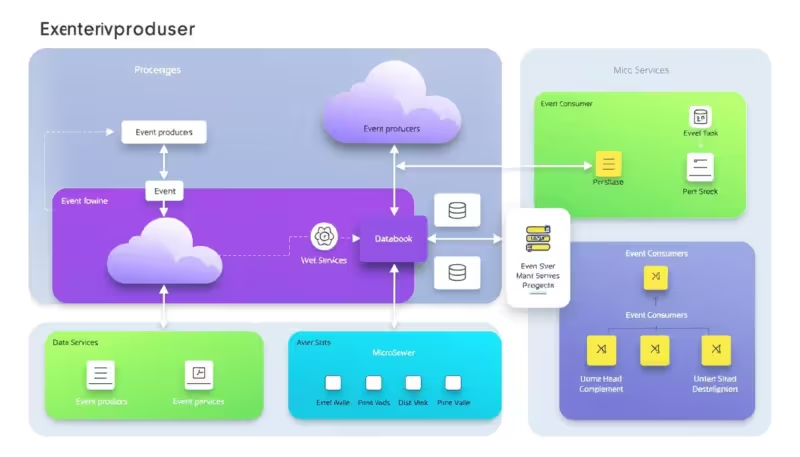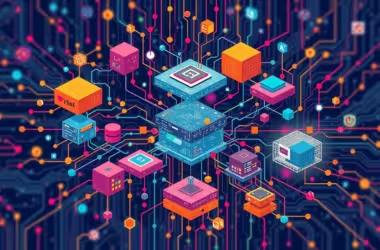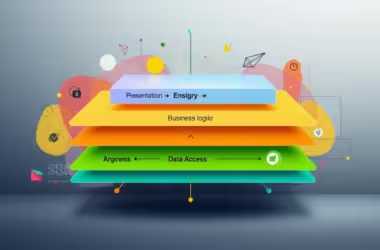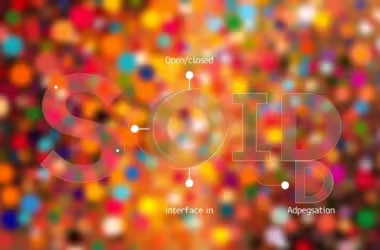In the fast-paced world of tech, Event-Driven Architecture (EDA) plays a vital role. It focuses on events, or significant changes, that affect how systems work. EDA is key in building applications that are quick to respond and process data in real time. This approach makes apps more adaptable, allowing them to handle changes smoothly.
Take an e-commerce site, for example. With EDA, it can scale up order handling or inventory checks as needed. This flexibility is essential, not just for instant updates in finance but also for making systems more robust. Through EDA, applications can smartly respond to events, which improves how users experience the service and boosts efficiency.
Understanding Event-Driven Architecture
Event-Driven Architecture (EDA) focuses on how events are key in systems. It sees events as signs of change or action in an app. The framework includes main parts: event producers, routers, and consumers.
Definition and Core Concepts
In EDA, event producers create events from user actions or system changes. Event consumers then react to these events using set rules. An event router sends events to the right consumers, making communication better. This setup helps services grow and stay safe from full system crashes if one part fails.
How Events Drive Application Logic
Events trigger actions in apps, making them work. They start workflows when something important happens. For example, in online shopping, user activity during busy times can make the system adapt. This keeps it stable without using too much resource. EDA helps apps be more flexible, improve user experience, and work better.
Key Components of Event-Driven Architecture
Event-Driven Architecture (EDA) includes key parts that work together for a smooth system. Knowing about event producers, event consumers, and event channels is key. They help make the most of EDA in any app.
Event Producers and Their Role
Event producers start the action in the EDA world. They create events that show changes, like user actions or updates from sensors. These events are sent into the system for instant action. This setup is flexible. Producers don’t need to know who will use their events. It keeps things loosely connected.
Event Consumers in Action
Event consumers wait for events they need and then act. When an event comes, they process it. This could mean updating databases or starting new tasks. It’s a way to use real-time data by handling many events at once.
Function of Event Channels
Event channels are the paths that connect producers and consumers. They use tools like Apache Kafka or RabbitMQ for safe event delivery. These channels help separate system parts. This makes it possible to wait to process events until the right time.
Benefits of Event-Driven Architecture
Event-Driven Architecture (EDA) is changing how we develop software. It brings big benefits for both businesses and developers. EDA benefits stand out as technology gets more complex. They shine in making software scale up easily and in speeding up development.
Scalability and Performance Enhancements
EDA’s key advantage is its scalability. Applications can grow and adjust easily to more work. For instance, an online store can handle orders and stock separately. This makes it simpler to expand and improves service as needs increase.
This method leads to better performance. Each part of the system can handle more tasks, smoothly and quickly.
- Real-time responsiveness enables applications to react instantly to events, providing ultra-low latency capabilities.
- Horizontal scaling distributes workloads across multiple instances, improving overall system efficiency.
- Fault tolerance ensures system continuity, even if individual components encounter issues.
Flexibility and Agility in Development
EDA also brings flexibility and agility to making software. It lets different parts of an app change without affecting others. This results in faster updates and the ability to adapt to new trends quickly. It’s especially useful when working with microservices, enabling quick and independent feature releases.
- Asynchronous processing enhances performance by enabling the handling of multiple events simultaneously.
- Decoupled architecture leads to higher development team velocity, fostering independence while minimizing coordination challenges.
- Integration with external systems becomes seamless, facilitating the incorporation of third-party services and APIs.
Event Flow and Lifecycle
The journey of an event starts with its creation and goes until it’s fully handled. Knowing how this works is key for handling events in an Event-Driven Architecture (EDA) the right way.
Event Generation and Propagation
Events start when something big changes. They are born from many places. This event generation sets off a series of actions across the system. They move through special channels, making sure signals go fast with little waiting. These pathways are crucial for keeping everything running smoothly.
Event Consumption and Processing
After being sent out, different parts of the system pick up these events. Each part can do something different. Some might just record what happened, while others do complex tasks that are key for the business. The event processing part is central. It decides how well the system reacts to new information or changes. Handling this part well is a must for using EDA to its fullest.
Key Concepts in Event-Driven Architecture
Event sourcing and CQRS are key to understanding event-driven architecture. They help keep systems responsive and efficient during complex tasks. By using these concepts, developers make apps that quickly react to events.
Event Sourcing Explained
Event sourcing records all application state changes as events. It’s more than just saving the latest state. Systems log every action, enabling state reconstruction at any time through stored events. This enhances auditability and aids in debugging, crucial for applications requiring high compliance.
Understanding CQRS (Command Query Responsibility Segregation)
CQRS separates read and write operations to boost system performance and scalability. Commands make changes; queries retrieve data from a special read model. This setup makes systems faster and allows for fine-tuning, ideal for handling many transactions and scalability needs.
Event Processing Patterns
Understanding event processing patterns is key for creating effective event-driven systems. These patterns categorize the different ways to handle events, affecting how applications perform and respond. They enable organizations to pick the right event processing approach, such as simple or complex processing, tailored to their needs.
Simple vs. Complex Event Processing
Simple event processing focuses on individual events. It offers direct responses to actions like user interactions or system alerts. On the other hand, complex event processing examines several events over time. It looks for patterns or insights, such as fraud detection or customer behavior analysis. Combining simple and complex processing can lead to better understanding and insights.
Stream Processing and Real-Time Analytics
Stream processing is vital for managing continuous data flows in real time. It provides immediate insights and responses. This is crucial in settings like IoT or financial markets, where quick decisions are based on fresh data. Real-time analytics can greatly improve efficiency and decision-making. Together, stream processing and real-time analytics show the importance of different event processing patterns in event-driven architectures.
Use Cases of Event-Driven Architecture
Event-Driven Architecture (EDA) has changed the way businesses work in different areas. It lets companies quickly respond to events, making them more efficient and responsive. Here are some important uses of EDA.
Real-time Analytics Applications
EDA plays a big role in real-time analytics. Companies use it to collect, process, and analyze data right away. This helps them make quick decisions. For example, stores can change their stock levels based on what’s selling at the moment.
This improves shopping for customers and makes supply chains better. Adding EDA to analytics makes systems that can handle lots of data fast and accurately.
Microservices Communication Strategies
EDA is key for microservices to talk to each other effectively. It allows services to react to events independently. This creates a smooth and efficient network. With EDA, companies can handle their services more easily and grow their operations when needed.
Brands like Netflix and Unilever use EDA for their apps. It helps them update quickly and keep everything working together smoothly.
Index of Other Diverse Applications
EDA is used in many areas like IoT, finance, and e-commerce. In logistics, it helps with quick updates and checks through dashboards. This makes businesses agile, letting them adapt fast to new situations.
EDA is also important in handling payments. It quickly deals with problems to make order processing more reliable.
Designing an Event-Driven System
To create a solid event-driven system, you need to follow best practices and use the right tools. This helps build systems that are easy to scale and maintain, even as needs change.
Best Practices and Considerations
Good event-driven design is based on key principles:
- Loose coupling: Keep event producers and consumers separate. This allows them to grow independently.
- Idempotency: Make sure handling the same event more than once won’t change the system.
- Robust event schema definitions: Have clear event schemas to make integration smoother and avoid problems.
Following these ideas makes your system more flexible and fast. It also boosts performance.
Key Tools and Technologies
Choosing the right tools is vital for a good event-driven architecture (EDA). Some top tech choices include:
- Apache Kafka: Known for handling lots of data very fast. Great for real-time data work.
- RabbitMQ: Good for managing queues and making sure events get where they need to.
- AWS Lambda: Helps with serverless event handling. This makes scaling easy and cuts down on costs.
Using these tools in your EDA makes your processes smoother. It lays a strong foundation for growth and flexibility.
Challenges and Solutions in Event-Driven Architecture
Event-Driven Architecture (EDA) has its challenges, like keeping events in order and managing their versions. These issues need smart solutions for the system to work well and adapt easily. Tackling these problems makes the architecture more reliable and efficient.
Addressing Event Ordering and Consistency
Keeping the right order of events in distributed systems is crucial. If events are not in sequence, the system might not act correctly. To solve this, certain steps are helpful:
- Employing sequence numbers and timestamps to preserve chronological order.
- Utilizing robust messaging platforms like Kafka, which provide strong ordering guarantees within partitions.
- Ensuring event handlers are idempotent, allowing the same message to be processed multiple times without negative effects.
- Assigning unique IDs to events to prevent duplicate processing.
- Regularly inspecting dead-letter queues to identify underlying issues within the system.
Handling Event Versioning and Evolution
As systems grow, managing how events evolve is key for compatibility. Changes should not disrupt ongoing activities. Here are effective ways to ensure smooth updates:
- Designing systems to gracefully handle event schema changes through versioning or flexible parsing.
- Utilizing tools like Confluent’s Schema Registry for Apache Kafka to manage and validate event schema changes.
- Ensuring all new event versions are backward compatible and forward consistent.
- Focusing on business behaviors rather than technical implementations enhances adaptability.
Conclusion
Event-Driven Architecture (EDA) changes how we design software, making systems more scalable and responsive. The benefits of EDA include better integration and more agility in development, which makes it popular for enterprise solutions. However, there are challenges like event ordering and versioning, but with the right strategies, these can be overcome.
When building an event-driven system for Supply Planning & Stock Management, the focus on events and best practices is key. Managing observability and maintainability is crucial. It’s especially important in handling critical events, such as PurchaseOrderChanged and ProductStockChanged. By tackling these issues, we can create strong architectures that adjust to changes well.
The future of EDA looks bright, with cloud computing and IoT growing. As real-time data becomes more important for business decisions, EDA’s benefits will be more recognized. This will help businesses stay resilient and agile as technology keeps advancing.
Source Links
- Unleashing the Power of Event-Driven Architecture: Key Concepts
- Event-Driven Architecture: Unleashing the Power of Asynchronous Communication
- Event-Driven Architecture
- The Complete Guide to Event-Driven Architecture
- Components of Event-Driven Architecture – 3Pillar
- The Complete Guide to Event-Driven Architecture | Solace
- Benefits of migrating to event-driven architecture | Amazon Web Services
- Discover the Pros of EventDriven Architecture
- Event-Driven Architecture Pros and Cons
- Event-Driven Architecture – System Design – GeeksforGeeks
- Event-Driven Architecture with the Saga Pattern Approach in AWS
- Event-Driven Architecture
- Event-Driven Architecture (EDA): A Complete Introduction
- Event-Driven Architecture: Basic Concepts
- The Ultimate Guide to Event-Driven Architecture Patterns | Solace
- What Is Event-Driven Architecture? Everything You Need to Know
- 4 event-driven architecture use cases (with examples)
- 10 Event-Driven Architecture Examples: Real-World Use Cases
- System Design: Event-Driven Architecture (EDA)
- Designing Event-Driven Systems | Confluent
- Potential pitfalls in the development of Event-driven architecture
- Event-Driven Architecture : Benefits, Challenges, and Examples
- Common issues when scaling event-driven architectures
- Some More Lessons Learned in Event Driven Architectures
- What’s the most important part of Event-Driven Architecture?






